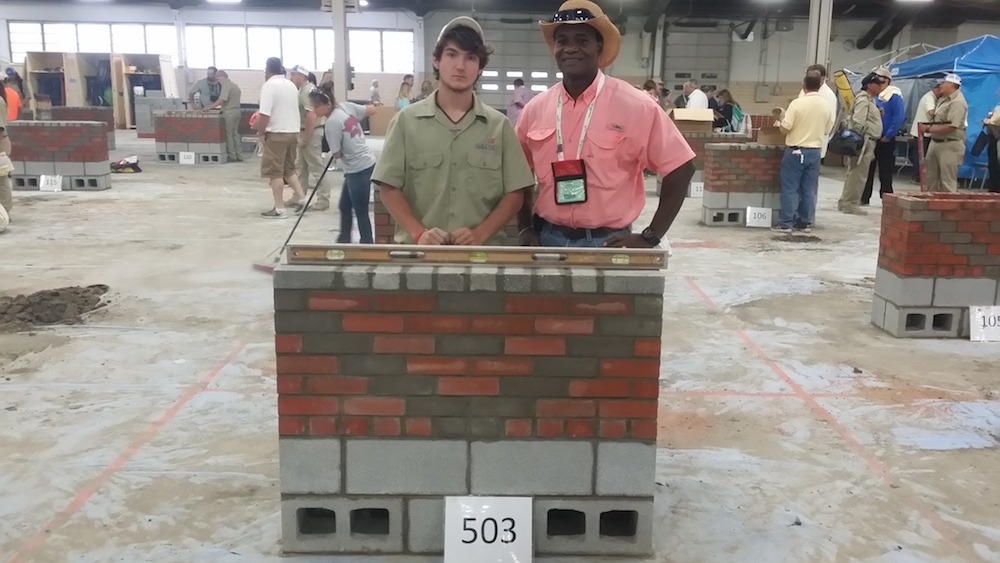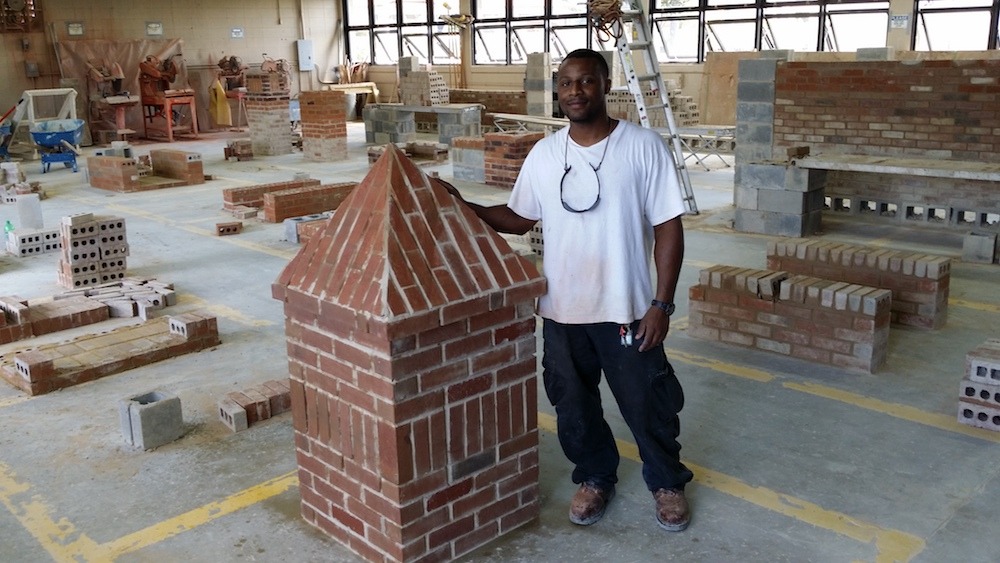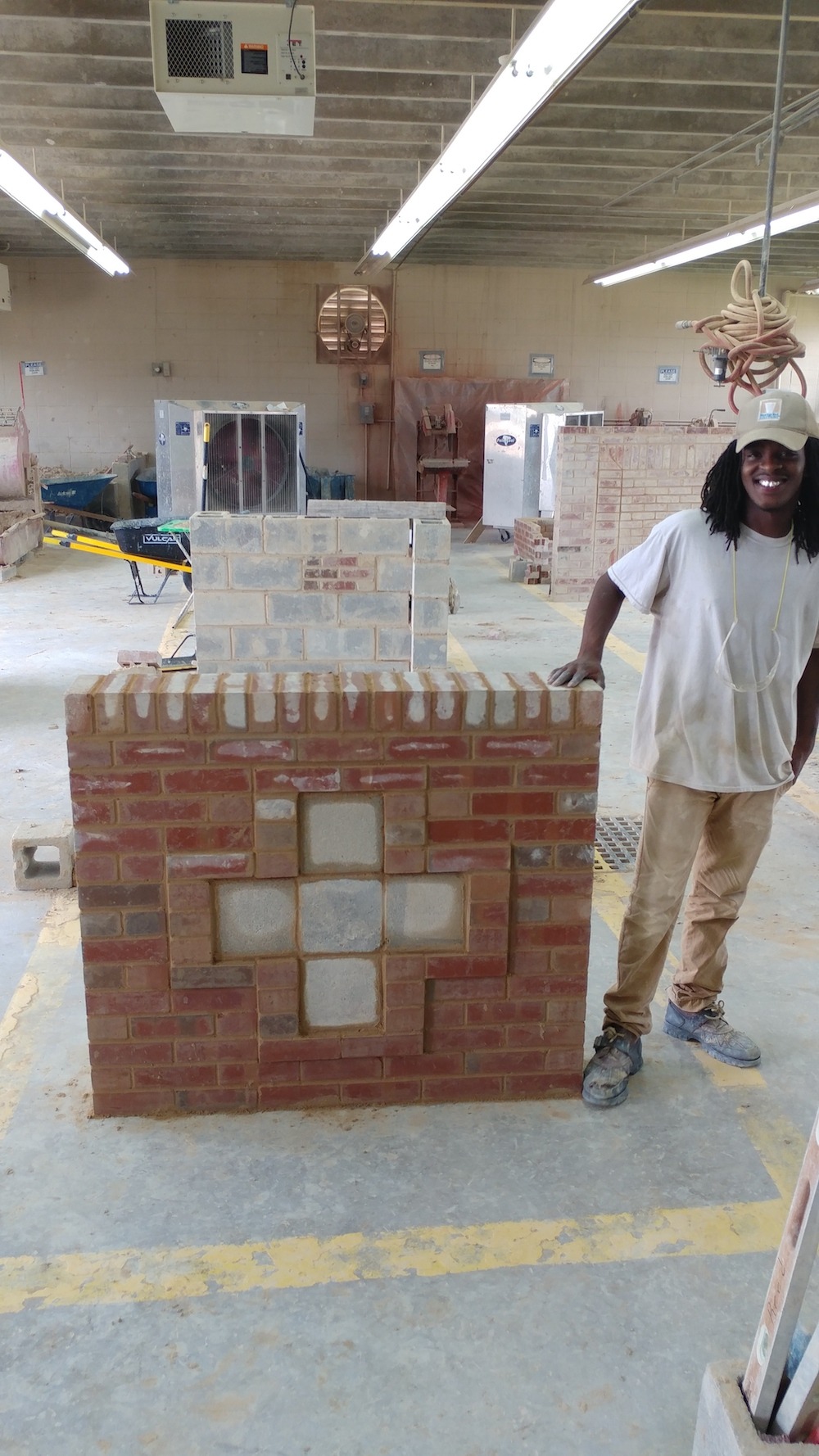Masonry instructor Kenny Allen has a lot to say about the trade. “The word ‘mason’ is universally accepted as one with the highest skill,” says Allen, who also serves as a recruiter for the Wallace Community College’s Selma Masonry/Building/Trades Program, an MCAA program in Selma, AL. “The vernacular of masonry permeates widely from biblical scholarship to literature and everyday language,” Allen says. “Masonry bookmarks mankind’s constructional evolution whereas other mediums are lost to the ages.”He’s quite passionate about the trade – and how the school’s program can help meld the masonry tradesmen and tradeswomen of tomorrow, enabling students “to market a skill that is timeless.”
“Instructors know that the skill of masonry was considered esoteric for centuries and exclusively passed down by familial generations,” Allen says. “Violating the secrecy thereof was punishable by death at one time. It was not until the Industrial Age that the recipes and techniques reached a wider population.” “Masonry and masons will never become obsolete as the skill cannot be mechanized economically,” he says. “The human eye and a meticulous touch cannot be mass produced.”
Moreover, architecture of residential homes can be cyclical, while the demand for brick homes has typically remained robust — “regardless what is in fashion,” according to market research, Allen says. Brick educational and civic buildings are standard, as it allows for added safety, uniformity of aesthetics and easier-to-obtain financial backing. A skilled mason can utilize his or her technical talents in a myriad of construction projects — from small interior brick work to colossal industrial buildings, he says. This flexibility allows a mason more financial security and opportunity than other skilled laborers in the construction field.
The main objective of Wallace’s program is to provide students with the education and training “to exceed the highest industry standards surpassing established licensing criteria — all while continuing centuries of respect and tradition for the trade,” Allen says. Wallace Community College’s program provides the student with theoretical and laboratory experiences which relate directly to all aspects of the masonry industry, he says. Options include a short certificate, a standard certificate and a certificate in advanced masonry, “allowing for a smooth transition” from classroom to employment in the masonry field.
The program, which encompasses the residential, commercial and industrial fields of masonry construction, offers courses that are designed both for beginning and advances masonry students – “giving all students the opportunity to learn a spectrum of skill levels from the very basic to the technically advanced,” Allen says. “The skills the program provides are essential for the student’s qualifications for masonry employment,” he says. “The courses cover a comprehensive range of technical information to handle any masonry issue, and the laboratory exercises are designed to give our students the best possible learning experiences. Upon graduation employers are pleased to find our graduates well versed in all possible masonry scenarios and are regarded by their peers as polished seasoned professionals.”
The program’s teachers are certified National Center for Construction Education Research instructors, which allows them to teach using the Center’s curriculum. The subject matter is broken down into three levels, Masonry Level 1, Level 2 and Level 3. Within the levels there are modules, which contain written test and performance evaluations. The curriculum’s scope and sequence satisfies all academic and practical requirements, Allen says. There are sixteen masonry courses that are taught along with two academic classes, Mathematics and English, which are taught outside of the program, but still on campus. The courses consist of five theory classes and eleven lab classes – “all of which are connected in one way or another.”
In the program’s fundamental classes, students learn basic masonry skills with regards to safety, spreading mortar for brick and block, buttering brick and block, laying brick and block to a line, using the plumb rule while laying brick and block, using good finishing skills, and identification of masonry tools and equipment. They are taught the basis of masonry material, which includes brick, block, and stone as well as the different type bond patterns. In the core classes, the focuses are on students performing block masonry, brick masonry, residential commercial masonry, stone masonry, fireplace construction, brick arches, basic cement masonry as well as special topics in masonry.
A recent trend in masonry is the use of refractory brick, and refractory regulations and compliance codes are addressed during lectures, along with the unique skills and materials knowledge that is associated with the trend. “The word refractory comes from the French word refractaire, meaning high melting point,” Allen says. “Since refractory has made a high impact on recent student employment and industry needs, it is definitely incorporated throughout the curriculum.” A special emphasis within the curriculum is placed on the application of mathematics — most notably, estimation. As Allen states, “[it’s] imperative for students to have an excellent understanding of predicting quantity and cost of materials, as well as, time and labor cost.”
“Students must have a working knowledge of blueprint reading, a fundamental ability to sketch and meet the objectives of other subjects essential to preparation for employment in the field of masonry,” Allen says. Wallace’s program can be completed in four semesters, for a period totaling twelve months. Students entering the program may enter at the beginning of any semester, as the courses are designed to rotate yearly. There are eight courses in the short certificate course of study, 16 masonry courses in the standard certificate course of study, and 20 masonry courses in the advanced certificate course of study. The objectives are sequential and concurrently taught to include all course levels. Students are tested with written and performance evaluations using the NCCER curriculum.
In addition to the masonry/building/trades program, Wallace Community College Selma also has a welding program, a drafting and design program, an electricity program, an industrial maintenance program, and a work force development program to help students strengthen “their soft skills,” such as developing resumes, filling out applications and prepping for interviews. The college also offers a business education program for students who want to gain knowledge in how to start and operate their own business. The students also learn office management skills, clerical skills and successful business practice techniques.
The motto of the masonry program – as it is with Wallace’s President Dr. James Mitchell – is succinct: “students enter to learn but leave to serve.” The team recruits students for the masonry program through career days, college fairs and recruitment fairs, which Allen and other instructors schedule with the surrounding high school counselors. Usually, they’ll take a day to come and talk to students about coming into Wallace’s programs.
At these events, Allen likes to use a particular presentation he made that includes a segment on the late Sam McGee, owner of the largest masonry company in North Carolina. The presentation allows the students to see how successful McGee had become “with a trowel in his hand and how he worked in the business world as a sales rep, but wanted more.”
“Mr. McGee told his brothers – who were mason contractors at the time – if they would show him how to lay bricks he would make them all millionaires… I found out one of the best things to aid in recruitment is real individuals who have proven masonry is a good career. When I show the students my presentation they are captivated by what they see in the slides.” For the college and career days, the area’s schools send out invites to various colleges to come and set up displays. Setting up display booths at the schools allows Allen and his colleagues the opportunity to communicate directly with students one-on-one.
“When they ask questions about our occupation, I talk to them about masonry being one of the top jobs in demand in the Federal Job Outlook Report. I also tell students about the benefits of choosing a career in the masonry industry, such as having the freedom and ability to start their own business, and once the skills are learned — no one can take it away.”
The program’s goal is to not only train students in the masonry trade, but to also help students find jobs in the industry. “I found the best practice for accomplishing this goal is to invite industry into our program. Industry personnel come in with presentations about their companies, in what they do and also what they are looking for in masonry tender and mason.” After their presentations, industry professionals give students the opportunity to ask questions, and the professionals will also provide their contact information for students’ use upon completion of the program.
“I have had lots of success with this system,” Allen says. “It gives industry personnel an opportunity to meet students where they are and it allows an opportunity to encourage student to come to class, be on time, work hard, develop good work ethics skills and finish the program.”Wallace’s masonry/building/trades program has an advisory board comprised of business and industry personnel that meets two times a year to discuss issues that may affect the program, as well as the industry. The members of the board are associated with industry “one way or another.”
“They have an open invitation to come by and mentor our students at anytime and they do. Most of the members take advantage of this opportunity when the college has its annual ACE Day. Many of the individuals are the same individuals who set up presentations about their companies to our students in hopes of hiring them.”
As a former student of Wallace’s masonry program from 1979 to 1980, he says it wasn’t hard to get involved again. The former masonry instructor and Allen’s teacher, Sam Johnson, was retiring and asked Kenny to take the job because he had the requisite knowledge and skills, and that he was the “committed, responsible and dependable person” needed to keep the program a success.
“I didn’t think I could do it, but Mr. Johnson believed I could and that was enough for me. However, after taking the job there were many challenges. The job transition from the masonry field to the college educational environment was easily the biggest challenge.” What advice would he give to someone interested in the industry? Allen provides a poignant perspective to students making their way through the program, telling them that first and foremost, masonry is one of, if not, the oldest trades in the world.
“Masonry is not going anywhere — it’s been around a long time and it will be around forever. People love brick houses, and they also love brick structures— all of them. If you learn the skills and techniques to do masonry work you will always have something to do.” In the three sectors of masonry — residential, commercial and industry — something is always being built in one, if not all, of those areas at one time another. He also tells students that when they build something with brick, they are establishing “a legacy that will last a long time.”
“Just take a good look at some of the brick houses and commercial buildings in your neighborhoods,” Allen says. “You will see structures that have been around forever. Some masons built them maybe 50 to 100 years ago and while the masons are long gone, their work is still standing.” Allen also lets students know that masonry is an industry they can “certainly be proud of” because everything they build will be critiqued for its quality and looks for years. “Everyone see the mason’s work continually, because the mason’s work is the last thing standing.”




